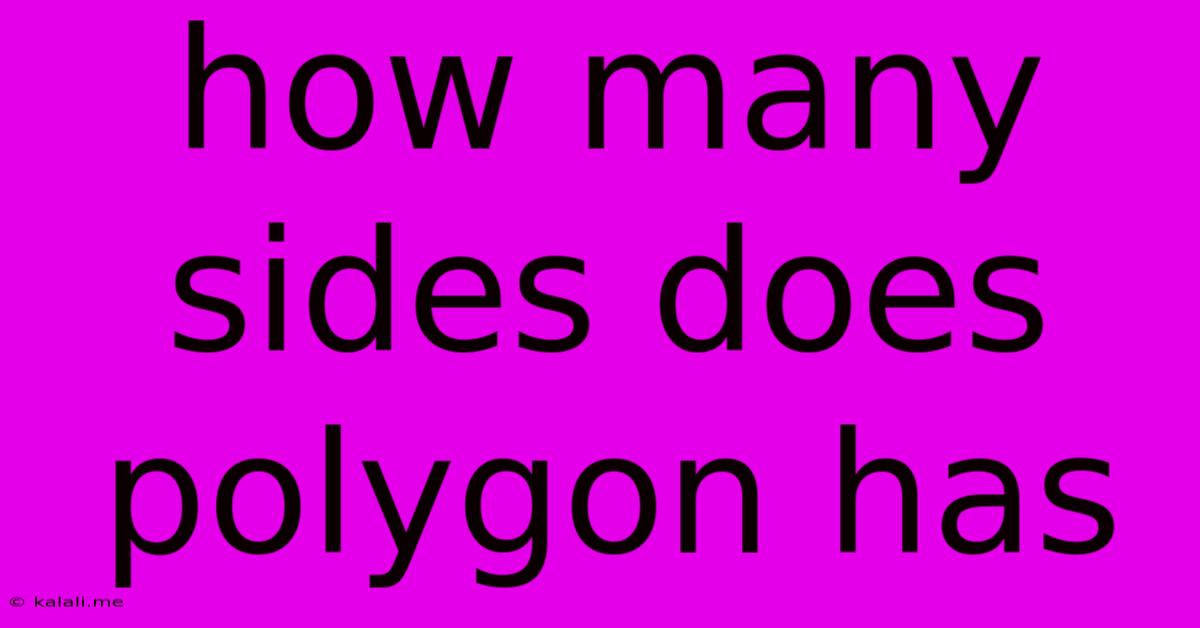How Many Sides Does Polygon Has
Kalali
May 21, 2025 · 3 min read

Table of Contents
How Many Sides Does a Polygon Have? A Comprehensive Guide
Meta Description: Understanding polygons? This guide explores the definition of polygons, categorizes them by the number of sides, and clarifies common misconceptions about their shapes and properties. Learn about triangles, quadrilaterals, pentagons, and more!
Polygons are fundamental shapes in geometry, yet the seemingly simple question of "how many sides does a polygon have?" opens a door to a surprisingly rich world of mathematical concepts. This article will explore the definition of polygons, categorize them based on the number of sides they possess, and dispel some common misconceptions.
What is a Polygon?
Before diving into the number of sides, let's establish a clear definition. A polygon is a closed two-dimensional figure formed by connecting three or more straight line segments. These segments are called the sides of the polygon, and the points where the sides meet are called vertices (or corners). Crucially, a polygon must be closed; meaning the line segments form a continuous loop with no open ends. Figures with curved lines or open ends are not polygons.
Classifying Polygons by Number of Sides
Polygons are often classified based on the number of sides they have. Here's a breakdown of some common polygon types:
- 3 Sides: Triangle (equilateral, isosceles, scalene) – The simplest polygon.
- 4 Sides: Quadrilateral (square, rectangle, rhombus, parallelogram, trapezoid, kite) – A diverse group with many subtypes.
- 5 Sides: Pentagon (regular pentagon, irregular pentagon) – Often associated with the shape of the Pentagon building.
- 6 Sides: Hexagon (regular hexagon, irregular hexagon) – Think of a honeycomb structure.
- 7 Sides: Heptagon (or septagon) – Less common, but still a valid polygon.
- 8 Sides: Octagon (stop signs are a common example)
- 9 Sides: Nonagon (or enneagon)
- 10 Sides: Decagon
- 11 Sides: Hendecagon (or undecagon)
- 12 Sides: Dodecagon
- n Sides: n-gon – This is a general term used to describe a polygon with 'n' number of sides. For example, a 15-sided polygon is a 15-gon.
Common Misconceptions
It's important to address some common misunderstandings about polygons:
- Concavity: A polygon can be convex (all interior angles are less than 180 degrees) or concave (at least one interior angle is greater than 180 degrees). Both are still considered polygons.
- Regular vs. Irregular: A regular polygon has all sides and angles equal in measure. An irregular polygon has sides and/or angles of different lengths and measures. Both are polygons.
- Self-Intersecting Polygons: While less frequently discussed, polygons can also self-intersect. Though their shape might appear complex, they still adhere to the basic definition of a closed figure formed by straight line segments.
Beyond the Basics
The number of sides isn't the only characteristic that defines a polygon. Other properties, such as interior angles, area, and perimeter, are equally important in understanding these fundamental geometric shapes. Exploring these properties further will provide a deeper understanding of the world of polygons and their applications in various fields, from architecture and engineering to art and design. Understanding polygons forms the foundation for more advanced geometrical concepts.
Latest Posts
Latest Posts
-
Toilet Not Flushing Properly Water Rises
May 21, 2025
-
Walk From Euston To St Pancras
May 21, 2025
-
How Many Planets Are In No Mans Sky
May 21, 2025
-
What Are You Up To Now
May 21, 2025
-
How Long Does It Take Tile Grout To Dry
May 21, 2025
Related Post
Thank you for visiting our website which covers about How Many Sides Does Polygon Has . We hope the information provided has been useful to you. Feel free to contact us if you have any questions or need further assistance. See you next time and don't miss to bookmark.